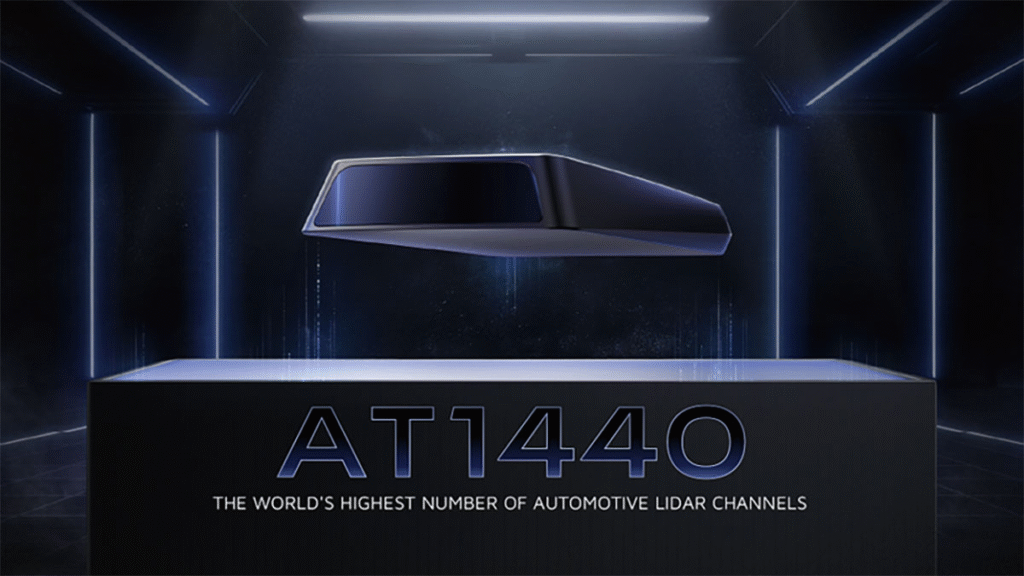Hesai Group, a leading Chinese lidar technology provider, is set to make a major leap in the autonomous driving sector with its announcement of a next-generation lidar system aimed at Level 3 autonomous vehicles, scheduled for launch in 2026. This innovation promises to double the detection range of its current best-selling model, the AT128, marking a significant milestone for both Hesai and the broader automotive industry.

Technical Deep-Dive
1. ETX: Long-Range Lidar with 400-Meter Detection
At the heart of Hesai’s new offering is the ETX lidar sensor, which boasts the world’s longest detection range for automotive lidar:
- Detection Range: Up to 400 meters at 10% reflectivity, a 30% improvement over previous models.
- Angular Resolution: Ultra-high resolution of 0.05° (horizontal) × 0.05° (vertical), delivering eight times the point cloud density of Hesai’s popular AT128 lidar.
- Sensor Window Size: Compact 32 mm diameter, enabling sleek vehicle integration.
- Eye Safety: Complies with Class 1 eye safety standards, ensuring safe operation in all conditions.
- Power and Size Efficiency: Designed to reduce power consumption and physical footprint, making it suitable for OEM integration behind windshields or other vehicle surfaces.
The ETX uses Hesai’s proprietary Photon Vector Technology, which enhances photon detection efficiency and signal processing, enabling longer range and higher resolution without increasing laser power.
2. FTX: Solid-State Lidar for Blind Spot Detection
Complementing the ETX, Hesai introduces the FTX solid-state lidar, engineered to cover blind spots and close-range detection zones:
- Field of View (FoV): Industry-leading 180° (horizontal) × 140° (vertical), providing comprehensive coverage around the vehicle’s sides.
- Detection Range: Effective up to 30 meters at 10% reflectivity, ideal for detecting pedestrians, bicycles, scooters, and low obstacles.
- Point Cloud Density: Generates 492,000 points per second, 2.5 times higher than previous solid-state models, enabling detailed object recognition.
- Compact Design: Features a reduced window size of 50 × 30 mm and a 66% weight reduction compared to earlier versions, allowing for seamless integration into vehicle body panels.
- Use Case: Specifically designed to eliminate blind zones created by rooftop lidar installations, enhancing safety in urban and complex driving environments.
3. Infinity Eye B Configuration: Multi-Lidar System for L3 Autonomy
Hesai’s Infinity Eye B system integrates the ETX and multiple FTX sensors to create a robust perception suite optimized for Level 3 conditional autonomy:
- Sensor Fusion: Combines long-range ETX lidar with two FTX solid-state lidars to provide 360-degree coverage with both far and near detection capabilities.
- Mounting Flexibility: ETX can be mounted behind the windshield, reducing aerodynamic drag and protecting the sensor, while FTX units cover critical blind spots.
- Data Processing: High-throughput data streams from these sensors feed into advanced perception algorithms capable of real-time object detection, classification, and tracking.
- Automaker Ready: Designed for easy integration into existing vehicle architectures, supporting OEMs in deploying Level 3 autonomous driving functions.
4. Technical Innovations Driving Performance
- Photon Vector Technology: Enhances lidar sensitivity and range by improving photon detection efficiency and reducing noise.
- High-Resolution Scanning: Fine angular resolution enables detailed environmental mapping, crucial for recognizing small or distant objects.
- Solid-State Reliability: FTX’s solid-state design eliminates mechanical parts, increasing durability and reducing maintenance.
- Low Power Consumption: Both ETX and FTX are engineered for automotive-grade power efficiency, critical for electric vehicles.
- Compact Form Factor: Smaller sensor windows and reduced weight facilitate flexible vehicle design and better aesthetics.
5. Production and Industry Impact
- Mass Production: Hesai plans to begin mass production of the ETX lidar by late 2026, with multi-year supply agreements already secured with leading European OEMs.
- Global Reach: Hesai’s lidar is currently used by major automakers including Nio, XPeng, Mercedes-Benz, and BYD, with the new systems expected to accelerate adoption of Level 3 autonomy globally.
- Competitive Edge: By delivering longer range, higher resolution, and multi-sensor integration, Hesai’s 2026 lidar system addresses key limitations of existing lidar technologies, positioning the company as a front-runner in automotive perception solutions.
The Next-Gen Lidar: Doubling the Detection Distance
Hesai’s upcoming lidar sensor is engineered to address one of the most critical requirements for Level 3 autonomy: long-range, high-resolution perception. According to CEO David Li, the new system will offer twice the detection distance of the AT128, which is already widely adopted by automakers and technology companies. This leap in capability means vehicles equipped with the new lidar will be able to detect obstacles, pedestrians, and traffic conditions much earlier, enhancing both safety and operational reliability on the road.
Why Level 3 Autonomy Needs Advanced Lidar
Level 3 autonomous driving allows vehicles to handle most driving tasks independently, but still requires a human driver to intervene in complex or unexpected scenarios. For this to be safe, the vehicle must have a robust perception system capable of accurately sensing its environment at long distances and in challenging conditions. Hesai’s new sensor is designed specifically for this purpose, enabling earlier warning and smoother transitions between automated and manual control.
Strategic Partnerships and Market Impact
Hesai’s lidar technology is already powering vehicles from leading electric vehicle manufacturers such as Nio and XPeng, and is integrated into platforms operated by global players like Mercedes-Benz, BYD, Baidu, and even Uber’s robo-taxi fleet in Dubai1. The company’s dominance in the lidar market is further reinforced by its ongoing collaborations with technology giants like Nvidia, positioning Hesai at the forefront of the global push toward safer, smarter mobility.
Industry Context and Competitive Edge
The global market for automotive lidar systems is experiencing rapid growth, driven by increased investment in autonomous vehicle technology and rising demand for advanced safety solutions. Hesai’s commitment to innovation—evident in its doubling of detection range and focus on high-resolution, wide-field-of-view coverage—underscores its competitive advantage in a crowded field35. The company’s new lidar is expected to play a pivotal role as automakers race to bring Level 3 vehicles to market.
Overcoming Geopolitical and Manufacturing Challenges
Despite facing geopolitical headwinds, Hesai is scaling up production, exploring overseas manufacturing, and maintaining a laser focus on technological advancement. These efforts are crucial for meeting the surging global demand for autonomous driving solutions and ensuring reliable supply to international partners.
Looking Ahead
With its next-generation lidar set for a 2026 launch, Hesai is poised to accelerate the adoption of Level 3 autonomous vehicles worldwide. The company’s technological breakthroughs, strategic partnerships, and manufacturing scale make it a central player in the evolution of smart mobility. As the race for autonomous driving supremacy intensifies, Hesai’s innovations are expected to set new industry benchmarks for perception, safety, and operational excellence.
In summary:
Hesai’s 2026 lidar launch represents a transformative step for Level 3 autonomous vehicles, promising unprecedented detection range and resolution. Backed by industry partnerships and a robust innovation pipeline, Hesai is set to shape the future of autonomous mobility on a global scale.
